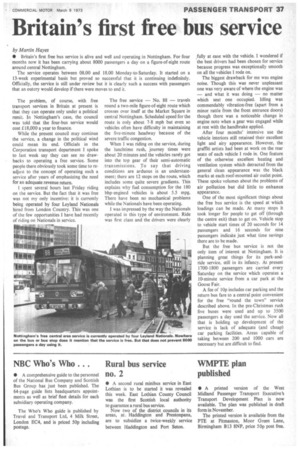Britain's first free bus service
Page 39

If you've noticed an error in this article please click here to report it so we can fix it.
by Martin Hayes
• Britain's first free bus service is alive and well and operating in Nottingham. For four months now it has been carrying about 8000 passengers a day on a figure-of-eight route around central Nottingham.
The service operates between 08.00 and 18.00 Monday-to-Saturday. It started on a 13-week experimental basis but proved so successful that it is continuing indefinitely. Officially, the service is still under review but it is clearly such a success with passengers that an outcry would develop if there were moves to end it.
The problem, of course, with free transport services in Britain at present is that they can operate only under a political remit. In Nottingham's case, the council was told that the four-bus service would cost 1.18,000 a year to finance.
While the present council may continue the service, a change in the political wind could mean its end. Officials in the Corporation transport department I spoke to last week say they can see no drawbacks to operating a free service. Some people there obviously took Some time to readjust to the concept of operating such a service after years of emphasizing the need for an adequate revenue return.
I spent several hours last Friday riding on the service. But the fact that it was free was not my only incentive: it is currently being operated by four Leyland Nationals hired from London Country. This was one of the few opportunities I have had recently of riding on Nationals in service. The free service — No. 88 — travels round a two-mile figure-of-eight route which crosses over itself at the Market Square in central Nottingham. Scheduled speed for the route is only about 7-8 mph but even so vehicles often have difficulty in maintaining the five-minute headway because of the severe traffic congestion.
When I was riding on the service, during the lunchtime rush, journey times were about 20 minutes and the vehicles rarely got into the top gear of their semi-automatic transmissions. To say that driving conditions are arduous is an understatement; there are 12 stops on the route, which includes some quite severe gradients. This explains why fuel consumption for the 180 bhp-engined vehicles is about 5.5 mpg. There have been no mechanical problems while the Nationals have been operating.
I was impressed by the way the Nationals operated in this type of environment. Ride was first class and the drivers were clearly ,fully at ease with the vehicle. I wondered if the best drivers had been chosen for service because progress was exceptionally smooth on all the vehicles I rode on.
The biggest drawback for me was engine noise. Though this was never unpleasant one was very aware of where the engine was — and what it was doing — no matter which seat one occupied. Idling was commendably vibration-free (apart from a minor rattle from the front entrance doors) though there was a noticeable change in engine note when a gear was engaged while at rest with the handbrake applied.
After four months' intensive use the vehicle interiors still retained their excellent light and airy appearance. However, the graffiti artists had been at work on the rear seats of each vehicle I rode in. One feature of the otherwise excellent heating and ventilation system which detracted from the general clean appearance was the black marks at each roof-mounted air outlet point. These spoke volumes about the problems of air pollution but did little to enhance appearance.
One of the most significant things about the free bus service is the speed at which loadings can be made. At many stops it took longer for people to get off (through the centre exit) than to get on. Vehicle stop to vehicle start times of 20 seconds for 14 passengers and 16 seconds for nine passengers indicate just what time savings there are to be made.
But the free bus service is not the only item of interest at Nottingham. It is planning great things for its park-andride service, still in its infancy. At present 1700-1800 passengers are carried every Saturday on the service which operates a 10-minute service from a car park at • the Goose Fair.
A fee of 10p includes car parking and the return bus fare to a central point convenient for the free "round the town" service described above. In the pre-Christmas rush five buses were used and up to 3500 passengers a day used the service. Now all that is holding up development of the service is lack of adequate (and cheap) car parking facilities. Areas capable of taking between 200 and 1000 cars are necessary but are difficult to find.




















































































































































